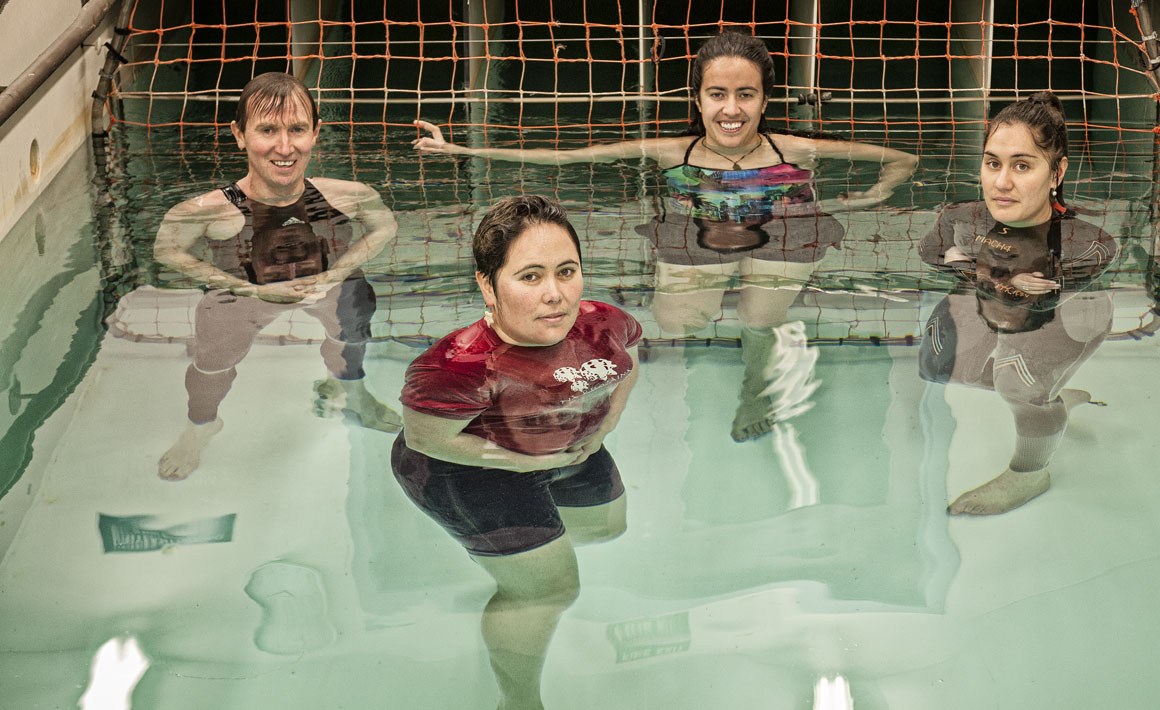 Professor Chris Button, Dr Anne-Marie Jackson, Terina Raureti and Dr Chanel Phillips: “If we can get to a place where whānau are confident, with a strengthened relationship to the water, then we can see if we can solve this issue of drowning.”
Professor Chris Button, Dr Anne-Marie Jackson, Terina Raureti and Dr Chanel Phillips: “If we can get to a place where whānau are confident, with a strengthened relationship to the water, then we can see if we can solve this issue of drowning.”A water safety programme drawing on Māori cultural knowledge is being developed to help combat the high number of Māori who drown each year.
Māori over-representation in drowning statistics highlights the urgent need for a Māori water safety programme, says senior lecturer in Māori Physical Education and Health Dr Anne-Marie Jackson.
“As Māori we've always had a strong cultural connection to the water'” says Jackson. When you ask someone 'Who are you', you ask 'Ko wai koe', 'What waters are you?'.
“So we have this strong connection ‒ culturally, through language, in the genealogical stories and histories ‒ but about 20 to 25 per cent of drownings over the last 10 years have been Māori, when Māori are only about 15 per cent of the population. There's an over-representation and we don't know why.”
Jackson is part of a team using a kaupapa Māori approach to develop a Māori water safety programme. The team includes researchers Dr Chanel Phillips, Dr Jordan Waiti, Professor Chris Button, Dr Jill Haszard, Ngahuia Mita, Danny Poa, PhD student Terina Raureti and master's student Shaquille Graham, as well as wai practitioners and community members Robert Hewitt, Brendan Flack, Mark Haimona and Tukaha Milne.
“…about 20 to 25 per cent of drownings over the last 10 years have been Māori, when Māori are only about 15 per cent of the population. There's an over-representation and we don't know why.”
The team will work with Māori communities in Northland, Waikato and Otago, drawing on their environmental and cultural knowledge around water-based activities (such as fishing, collecting food and diving) to develop key Māori water safety competencies.
“It always comes back to this idea of flourishing wellness, of Mauri Ora,” says Jackson. “It's about recognising that there is an issue, and to solve it we have to look at the strengths of our culture and our communities, as therein lie the answers.”
The three-year project, Tangaroa Ara Rau: Māori Water Safety Programme for Whānau, is based on a Māori water safety model developed by Phillips. Researchers will begin by examining the literature and gathering information from the selected communities to form the water safety programme. They will then recruit whānau, test their existing knowledge and practice of the key competencies, teach the programme, then follow with retesting and, later, a retention test. They will then look at refining and disseminating the programme.
“We recognise that every place has its own protocols and environments, but we think our work can be transferable to anyone in New Zealand ‒ and ideally the world,” says Jackson.
“If we can get to a place where whānau are confident, with a strengthened relationship to the water, then we can see if we can solve this issue of drowning.”
Funding
- Health Research Council
